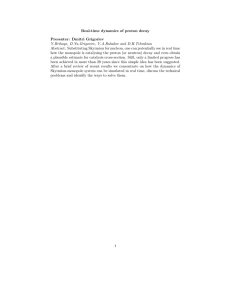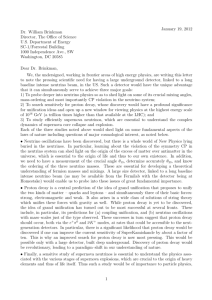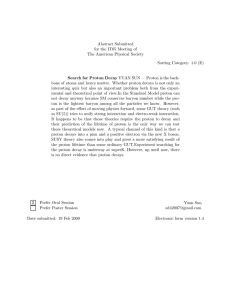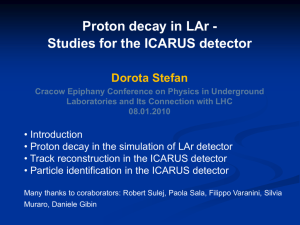Document 13646589
advertisement
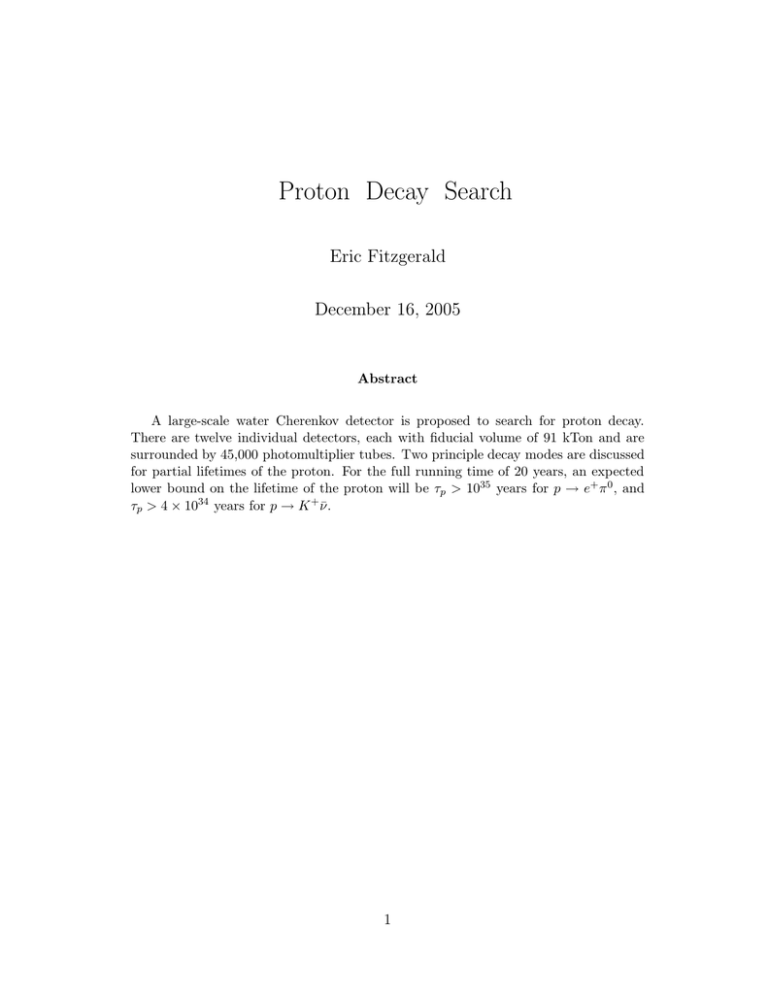
Proton Decay Search
Eric Fitzgerald
December 16, 2005
Abstract
A large-scale water Cherenkov detector is proposed to search for proton decay.
There are twelve individual detectors, each with fiducial volume of 91 kTon and are
surrounded by 45,000 photomultiplier tubes. Two principle decay modes are discussed
for partial lifetimes of the proton. For the full running time of 20 years, an expected
lower bound on the lifetime of the proton will be τp > 1035 years for p → e+ π 0 , and
τp > 4 × 1034 years for p → K + ν̄.
1
Contents
1
Why Proton Decay?
3
2
Detector History
4
3
The MegaTon Cherenkov Detector
5
4
5
3.1 Design . . . . . . . . . . . . . . . . . . . . . . . . . . . . . . . . . . . . . . .
5
3.2 Calibration . . . . . . . . . . . . . . . . . . . . . . . . . . . . . . . . . . . .
7
Signal Analysis
8
4.1 Cherenkov Signals . . . . . . . . . . . . . . . . . . . . . . . . . . . . . . . . .
8
4.1.1
p → e+ π 0 . . . . . . . . . . . . . . . . . . . . . . . . . . . . . . . . .
9
4.1.2
p → K + ν̄ . . . . . . . . . . . . . . . . . . . . . . . . . . . . . . . . .
11
4.1.3
Neutrinos . . . . . . . . . . . . . . . . . . . . . . . . . . . . . . . . .
12
Conclusion
12
2
1
Why Proton Decay?
Perhaps the first thing to ask about a proton decay search is why do we expect the proton to
decay? Sakharov first proposed in 1967 three postulates that needed to be satisfied in order
to explain the universe as we observe it assuming it evolved from a “Hot Big Bang”. The first
is a CP-violating reaction (to account for the matter/anti-matter asymmetry), the second is
a period of non-equilibrium dynamics (to form galaxies) and the third is a baryon-number
violating process (to have baryonic matter in the universe). It is this third process that we
are focused on: if baryon number is not perfectly conserved (as has been observed thus far),
then the lightest baryon (the proton) must be unstable and decay. So in order to explain
how the baryonic matter in our universe originated, that baryonic matter must decay.
The best theories that incorporate the Standard Model (SM), while at the same time extending it to include baryon decay, are so-called Grand Unified Theories (GUTs). They
work under the assumption that the forces we see in the SM are really artifacts of a single
force from a larger symmetry that was broken at a much higher energy scale. This new force
introduces new particles whose masses are of the order of the energy scale at which the larger
force was broken – the GUT scale (∼ 1016 GeV). These new particles, sometimes called “X”
and “Y” bosons, can intermediate interactions which would violate baryon number, causing
the proton to decay. And while this reaction would violate some of the symmetries we see in
the SM like baryon and lepton number, it would preserve the larger symmetries of the GUT.
The original GUT proposed was SU(5), it is the smallest gauge group that can contain the
SM gauge groups SU(3) × SU(2) × U(1). And while the original minimal SU(5) has been
ruled out because it predicts a lifetime of the proton much shorter than the current limits,
there are many viable extensions of it as well as more exotic gauge groups that can reduce
to the SM.
Figure removed for copyright reasons.
Figure 1: This is the non-SUSY GUT reaction for the decay of a proton intermediated by
an “X” boson. It takes a proton and goes to a pion and a positron.
There are two main types of GUTs, ones that simply try to incorporate the SM and others
3
Figure removed for copyright reasons.
Figure 2: This is a SUSY GUT reaction for the decay of a proton intermediated by a gluino
and includes a 4-lepton/slepton vertex. It takes a proton and goes to a kaon and a neutrino.
that also incorporate supersymmetry (SUSY). From the first ones, the principle decay mode
is p → e+ π 0 , while the SUSY GUTs predict the dominant decay mode to be p → K + ν̄.
Naturally, each specific model predicts which decay modes will contribute and in what proportion. The figures display some of the more common decay modes predicted; one is for a
regular GUT and the other is for a SUSY GUT. Since these are predicted to be the dominant
decay modes, these two reactions will be the focus of the search for proton decay.
2
Detector History
The world’s current best limits on the lifetime of the proton come from the Super Kamiokande
(SuperK) water Cherenkov detectro experiment in Japan’s Kamioka mine. This detector
design is based on that very successful model. Unfortunately, the only way to continue to
push up the lower limit of the proton lifetime is to look at more protons for longer. With
this in mind, each individual detector is designed to have 4 times the fiducial volume of the
SuperK detector, which is then copied and repeated a dozen times. The designed run time
will be 20 years. The current upper limits placed on the dominant decay modes that will be
discussed are from SuperK ([1],[2]).
τp > 5.4 × 1033 yr for p → e+ π 0
τp > 2.3 × 1033 yr for p → K + ν̄
Despite the successes of SuperK there has been one major problem. On November 12, 2001,
several thousand of the inner detector PMTs were destroyed in a cascade failure. The PMTs
are designed to be able to withstand depths in water of up to 80 m without needing additional
4
Figure removed for copyright reasons.
"Review of Proton Decay Results" lecture slides by Ed Kearns at Snowmass 2001.
http://hep.bu.edu/~kearns/pub/kearns-pdk-snowmass.pdf
Figure 3: An open view of the Super Kamiokande detector.[6]
housing[8]. While refilling the detector, one PMT collapsed and caused a pressure wave which
destroyed virtually all of the PMTs that were under water at the time. The current best
technology for PMTs are the same PMTs used in SuperK and are 10 years old, and new
improvements could certainly be made. Better quantum efficiency for detecting Cherenkov
photons, a flatter surface to allow for a wider acceptance, stronger housing without needing
additional support and cheaper mass production cost are all areas of possible improvement
in PMT design. One of the principle goals of the R&D for this project will be to design a
better PMT to meet these needs.
3
The MegaTon Cherenkov Detector
3.1
Design
This detector consists of multiple large water Cherenkov detectors. The design for an individual detector is a spherical inner detector (ID) shape, 60 m in diameter housed in a larger
cylindrical outer detector (OD) to act as a veto. The ID, with a diameter of 60 m will have
5
113 kT of water contained in its volume. However, due to constraints in reconstruction of
events, only about 91 kT will be part of the fiducial volume. The inner and outer detectors
must be optically sealed off from each other as much as possible. Any gaps in the construction of the structure must be covered over with thick, black polyethylene sheets to ensure
light from the OD doesn’t enter the ID. This design will then be repeated 12 times to give
a total fiducial volume of 1.1 MT. The total fiducial volume will contain 3.7 × 1035 protons.
Figure removed for copyright reasons.
Figure 4: An artist’s rendition of the proposed detector design. This design would be copied
for 12 total detectors.
The best phototubes currently in production (and the ones SuperK used) are Hamamatsu
R3600-06 50 cm hemispherical photomultiplier tubes (PMTs). As stated earlier, further
R&D work is hoped to improve upon this model, but for now this model will serve as a
guide. The ID will be lined with PMTs to have a coverage of 50%, requiring approximately
45,000 PMTs in each detector. The OD will only need about 15,000 PMTs since it’s not doing
precision tracking but rather being used as a veto from cosmic rays and other background
events. This gives 60,000 PMTs in each detector, or about 720,000 PMTs total. The ideal
scenario would allow for these PMTs to be directly submerged in water. In the frequency
region (high-frequency optical) that is of interest, the quantum efficiency of the PMTs is
between 10-20%. Due to the hemispherical design, the maximum acceptance angle of the
PMTs is about 75o , with acceptance at this angle roughly 50%. However, because the 2 m
closest to the PMT wall is considered “dead space” and not part of the fiducial volume (it’s
too difficult to reconstruct events so close to the wall), this acceptance is enough.
The reason for the spherical design is to minimize the flight distance for the Cherenkov photons from the decay products. Also, the spherical design would help with the reconstruction
of events due to the symmetry of the detector. While the overall design is to simplify these
considerations, there are some other things that will be more difficult. A spherical shape
will be more difficult to build “in-situ”, so considerable engineering effort and analysis will
6
have to be spent to ensure the support structure for the PMTs is stable. The PMTs will
be assembled in groups of 12 in modules that will be installed individually onto the superstructure. Tessellating these modules onto this curved surface will also require some work,
but similar work on a much smaller scale was done for the SNO experiment in Canada.
There are many other considerations to take into account before construction could begin,
the most important of which is the site that would be chosen to house the detectors. It
needs to be well-shielded from cosmic rays, so a good figure of merit would be protected
by 4000 mwe (meters-of-water-equivalent). SuperK was approximately 2600 mwe and had
a subsequently larger atmospheric background. 4000 mwe is a very attainable goal, since
many other cosmic ray and neutrino studies have been done at that depth (Homestake mine
is an excellent example). The walls surrounding the detector should have a low activity rate.
The OD protects the ID from most natural radioactivity, however radon levels in the air
can build up in the mine where the detectors rest. To offset this problem, the air for the
detectors will be drawn from outside the mine/cave and filtered to keep this background to
a minimum. SuperK also ran into a problem of an excessive magnetic field from the Earth
(∼450 Gauss) which caused their PMTs to behave poorly. This was well above the ambient
magnetic field of the Earth (∼50 Gauss), and hopefully a site can be chosen that will not
have this problem. If this does become a problem, though, large Hemholtz coils can be used
to partially cancel the magnetic field and allow for normal operation of the PMTs.
The two most important things for a water Cherenkov detector are the PMTs, which have
been discussed at length, and the water itself. The water must be highly purified in order
to allow for the longest attenuation length possible. The water purification system would
involve several filtration systems, including reverse osmosis and degasification. SuperK’s
filtration system was able to achieve optical attentuation lengths of up to 100 m, a similar
performance can be expected. This is extremely important to ensure that the photons
radiated undergo minimal attentuation and scattering.
3.2
Calibration
With 12 seperate detectors all running at the same time, it will be crucial to eliminate
systematic errors in the design by proper calibration. Water transparency can be measured
using a diffuser ball lit up by a laser from a fiber optic guide, most importantly in the 350
nm-500 nm wavelength regime. To allow for frequency-dependent measurements, frequencysplitting filters can be employed. Also, the laser light could be directly shined into the
detector to measure the scattering of light in the frequency regions the Cherenkov radiation
is emitted and the PMTs are most sensitive to.
Besides ensuring the purity of the water, the PMTs themselves must be calibrated. Again,
7
a light ball placed in the center of the detector and shined can give the relative gain for
all the PMTs at a specific wavelength. This can also be used to check the timing circuitry
of any PMTs that need to be verified. Other sources besides light can be used to test the
detector response. A small, low energy linear accelerator can be used to accelerate electrons
into the detector to calibrate the absolute energy scale for the reconstruction of electrons.
A Deuterium-Tritium Generator (DTG) can be employed to bombard the oxygen nuclei
in the water to create N 16 , which has a half-life of 7.13 s. This decays into a 4.3 MeV
electron coincident with a 6.1 MeV γ ray. This would provide an important check for the
reconstruction of low-energy γ rays.
4
Signal Analysis
4.1
Cherenkov Signals
There are two primary decays modes of the proton that will be searched for, p → e+ π 0 &
p → K + ν̄. Both of these provide unique signatures to cut on. Before discussing the specifics
of each signal, first lets discuss how water Cherenkov detection works. A charged, relativistic
particle that is travelling faster than the speed of light in the medium will emit Cherenkov
light in a cone at a specific angle depending on the velocity of the particle. The relevant
equations are [10]:
dErad
dx
1
cos θC =
βn
�
�
�
q2
1
= 2
ω 1 − 2 2 dω
c
β n
For water, with n = 1.33, the particle must be travelling above β > .75 or have a γ > 1.5.
The energy loss is about 500 eV/cm in the spectrum we are interested in, carried away by
about 200 photons/cm. This energy loss is quite small compared to the overall energy loss
due to ionization in the water, which is several MeV/cm. Since the particles involved in
these decays can only have a maximum energy of a few hundred MeV, they will only radiate
for a very short time before falling below the Cherenkov threshold. The PMTs then detect
the emitted radiation, which is typically in the short-wavelength optical range. By using
the timing of the PMTs, angle of the cone and the pulse height response of the PMTs, the
vertex can be reconstructed as well as the energy of the particle. Particle ID is performed
based on the topology of the event. Stongly confined rings are muons, while electrons and γs
“shower” due to the superposition of multiple rings being created by their pair-production
partners, giving a wider ring. Given the size of the detector, the number of Cherenkov
photons emitted for an average radiating particle and the quantum efficiency of the PMTs,
8
there will be between 30-70 PMTs signalling for each Cherenkov ring produced by a radiating
particle to provide the vertexing and energy measurements.
Figure removed for copyright reasons.
"Review of Proton Decay Results" lecture slides by Ed Kearns at Snowmass 2001.
http://hep.bu.edu/~kearns/pub/kearns-pdk-snowmass.pdf
Figure 5: SuperK event 27128713. The forward two (three) cones of light form the π 0 , while
the faint backwards cone is for a π + . This is for the possible decay mode p → K + ν̄, K + →
π + π 0 . This is real SuperK data, and was considered a possible proton decay event, but was
rejected in analysis cuts. [6]
4.1.1
p → e+ π 0
In this decay mode, the emitted electron is relativistic, while in the opposite direction the
π 0 immediately decays to 2γ. These high energy γs will interact in the water and pairproduce. The radiation length of water is 36cm, and the subsequent electron-postiron pairs
will Cherenkov radiate. So the signature for this decay mode would be one electron-like
showering ring with energy of a few hundred MeV, and in the opposite direction 2-3 lowenergy showering rings. With the lower-energy rings, a π 0 mass cut can be applied to the
invariant mass reconstructed from the rings. Also, these rings should be within 1 m of the
backwards electron and coincident in time. Together the energy of the rings should reconstruct to the original proton mass. SuperK was able to acheive a total of 43% reconstruction
efficiency in this decay mode using these broad cuts.
9
Figure removed for copyright reasons.
"Review of Proton Decay Results" lecture slides by Ed Kearns at Snowmass 2001.
http://hep.bu.edu/~kearns/pub/kearns-pdk-snowmass.pdf
Figure 6: Atmospheric neutrino Monte Carlo background for p → e+ π 0 . SuperK predicted
.25 events/100kTon/year. [6]
The primary background for these events are electron neutrino charged current events from
atmospheric showers which breaks up a nucleus. SuperK Monte Carlo results estimated this
background to be .25 events/100kTon/year. This gives about 4 events/year between the
12 detectors. However, by sacrificing some reconstruction efficiency, the background can
be reduced to about .15 events/1MTon/year. The reconstruction efficiency drops down to
only 17%, unfortunately. Further Monte Carlo studies would be warrented to study how
to maximize efficiency to background. The neutrino background is irreducible, there is no
detector design that can partially eliminate this. But given these backgrounds and a run
time of 20 years, the lifetime of the proton in this decay channel could be pushed as high as
1 × 1035 [5].
10
Figure removed for copyright reasons.
"Hyper-Kamiokande project" lecture slides by Masato Shiozawa at the JHF-Kamioka nu Workshop,
May 2001. http://neutrino.kek.jp/jhfnu/workshop2/ohp/shiozawa.pdf
Figure 7: Estimated expected lower limits on the lifetime of the proton in the p → e+ π 0
channel based on run time and size of detector, given in MTon-years. [5]
4.1.2
p → K + ν̄
While this decay mode is favored by many SUSY GUTs, it has several inherent experimental
problems. The first is that much of the proton’s energy is taken away by the neutrino and
thus can’t be fully reconstructed and cut on the mass of the proton. The second is that
the kaon also typically decays with a neutrino, so it cannot be reconstructed accurately.
Also, the initial kaon is not relativistic and will not Cherenkov radiate. However, this event
does have a very unique timing signature. A proton inside an oxygen nucleus decays into a
neutrino and kaon. The kaon is low-energy and will almost immediately come to rest through
ionization loss in the water, while the neutrino escapes. The leftover nucleus is an excited
∗
N 15 nucleus, which immediately decays through a prompt γ of 6.3 MeV into N 15 . If this γ
can be collected, there is a window between it and when the kaon decays 12 ns later. The
K + will decay 63% of the time into a muon and neutrino. This muon will Cherenkov radiate
briefly before coming to rest. Again, there will be a long time window for the lifetime of the
muon, 2.2 µs, and then it will decay into an electron and two neutrinos, with the electron
providing another Cherenkov ring. The primary cut for this decay mode is a timing cut. A
window of 12 ns between the prompt γ and the muon, then another 2.2 µs window between
the muon and the electron. Collecting and identifying the prompt γ is the largest inefficiency.
11
Some simple momentum constraints can be applied to the muon because it is involved in
2-body decays. The electron, due to muon decay being a 3-body event, will have a larger
momentum distribution. Again, the background comes from atmospheric neutrinos. SuperK
was able to achieve a reconstruction efficiency of 8.7%, while limiting background to .125
events/year. This means for a megaton detector a background of 3-4 events/year. Again
with some sacrifices to reconstruction efficiency, over a 20 year runtime, the partial lifetime
of the proton could be pushed as high as 4 × 1034 years [5].
Figure removed for copyright reasons.
http://lanl.arxiv.org/PS_cache/hep-ex/pdf/9904/9904020.pdf
Y. Hayato, M. Earl, et.al��
Search for proton decay through p->\bar{\nu} K^+ in a large water Cherenkov detector
http://arxiv.org/abs/hep-ex/9904020
Figure 8: Monte Carlo simulation from SuperK for the prompt-γ peak expected in p → K + ν̄.
The error bars are for 33 kTon-years of data at SuperK. [2]
4.1.3
Neutrinos
Another important physics goal which was not discussed here, but is very relevant for these
large scale Cherenkov detectors, is neutrino physics. This detector would be an ideal device
for studying atmospheric and solar neutrinos, as well and being a possible target for long
and short baseline neutrino beam experiments. Further studies and proposals should be
considered along these lines.
5
Conclusion
Super Kamiokande set out to push the realm of physics in nucleon decay by an order of
magnitude, and they accomplished their goal. But the proton decay limits can only scale
linearly with time and volume, and after running for 5 years, there won’t be much more
significant improvements in this area from SuperK. A new detector is needed, an order of
magnitude larger to push the limits up by an order of magnitude. This detector design will
increase the fiducial volume over SuperK by a factor of 20, and is designed to run for 20
12
Figure removed for copyright reasons.
Undagoitia, T. Marrodan, et al. Search for the proton decay p->K+antineutrino in the large liquid scintillator low energy neutrino astronomy detector LENA.��
http://arxiv.org/abs/hep-ph/0511230��
Figure 9: Monte Carlo simulation for the distribution in time intervals for the prompt-γ to
the kaon decay. A 7 ns cut yeilds a reduction factor of 2 × 104 against background. [3]
years. With these parameters in mind, the lower limit on the lifetime of the proton will
be pushed up to 1035 years. While the original SuperK was able to rule out the minimal
SU(5) GUT, this kind of limit would rule out large portions of both SUSY and non-SUSY
type GUTs. This physics goal is technologically availible and can teach us more about what
physics is like at the 1016 GeV scale, and how the forces of the SM interact at those higher
energies.
13
References
[1] T. Hakaya, Nucl. Phys. B (Proc. Suppl.) 138, 376 (2005).
[2] Y. Hayato et al. (Super Kamiokande Collaboration) (2005) hep-ph/9904020.
[3] T. Marrodan Undagoitia et al. (2005) hep-ph/0511230.
[4] Super-Kamiokande at SUNY, Stony Brook. http://ale.physics.sunysb.edu/nngroup/superk/
[5] Masato
Shiozawa,
Hyper-Kamiokande
http://neutrino.kek.jp/jhfnu/workshop2/ohp/shiozawa.pdf
Lecture
(2001)
[6] Ed Kearns, Snowmass Lecture (2001) http://hep.bu.edu/ kearns/pub/kearns-pdk-
snowmass.pdf
[7] S. Fukuda et al. (Super Kamiokande Collaboration), NIM Physics Research A 418-462
(2003).
[8] Hamamatsu Corporation, Photomultiplier Tube R3600-02, -06 Datasheet (1999).
[9] The Particle Data Group, Particle Detectors Section. (2004)
[10] J.D. Jackson, Classical Electrodynamics, Third Edition, pgs. 637-40. (1998)
[11] D. Casper, The Super-Kamiokande Experiment (lecture).
[12] D. Perkins, Introduction to High Energy Physics, Fourth Edition, pgs. 361-3. (2000)
14
